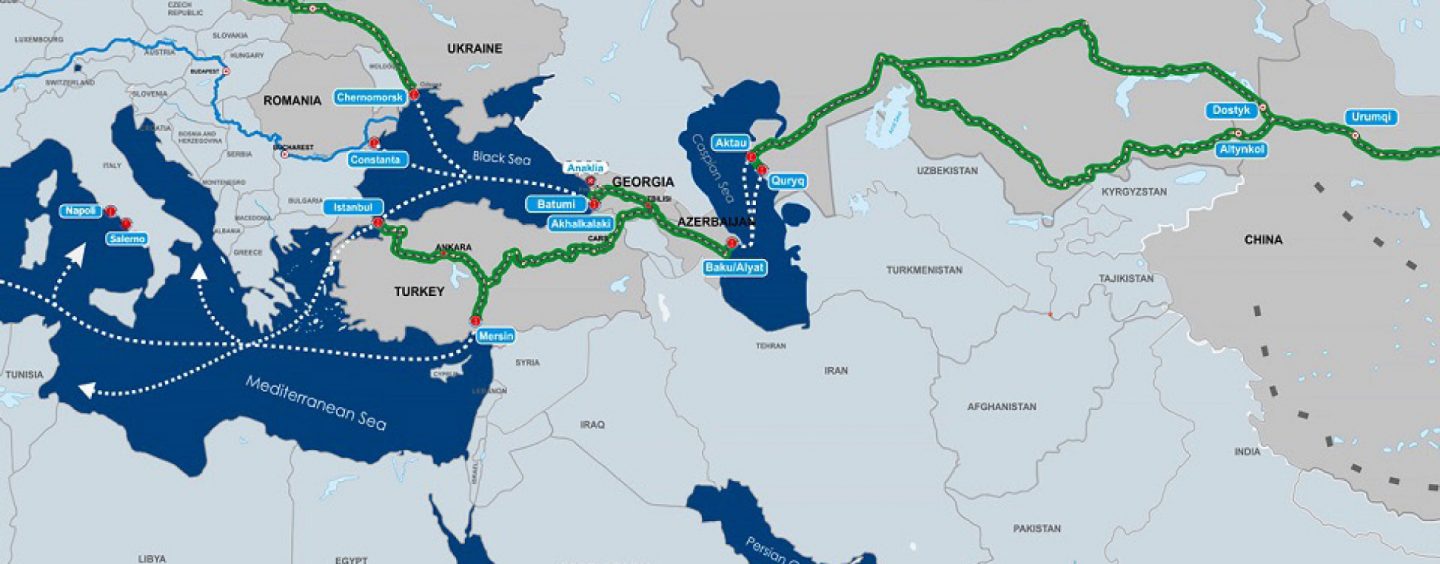By Dr. Vakhtang Maisaia Professor, Caucasus International University (CIU) Ph.D. in Political Science, Georgia
The South Caucasus region is increasingly becoming a priority on the international agenda. In fact, a regional approach is emerging as actors understand that common problems need to be addressed jointly. Nevertheless, cooperation efforts are hampered by a number of factors, such as uneven economic and political development within and among countries, nationalist forces, and longstanding animosities between regional players. In this context, it is imperative to foster sound policies aimed at strengthening dialogue and cooperation so as to contain and ultimately resolve conflicts with peaceful means. However, there is little policy-oriented research on the challenges and opportunities for cooperation in the South Caucasus region based on devleopment of the “Middle Transit Corridor”.
The Trans-Caspian International Transport Route (TITR-Middle Corridor) starts from Southeast Asia and China, runs through Kazakhstan, the Caspian Sea, Azerbaijan, Georgia and further on to European countries. Kazakhstan, Azerbaijan, and Georgia announced in late June of this year that they are seeking to unify rail tariffs and set up a joint logistics company. This marks a major milestone in the process of expanding the Trans-Caspian International Transport Route (TITR) into the long-anticipated Middle Corridor between Europe and China. The Middle Corridor is a shorter and sanctions-free alternative to the Eurasian Northern Corridor, which runs through the Trans-Siberian Railway, Trans-Manchurian Railway, Trans-Mongolian Railway, and the Baikal Amur Mainline. The Russian route used to carry more than 90% of the rail traffic between Europe and the Far East prior to the war—yet now, with sanctions reducing shipments over the Eurasian Northern Corridor by as much as 40% last year, support for the Middle Corridor is growing. The wider region is already busy building railways and other infrastructure. Kazakhstan alone has built 2,500 km of railway in the past six years, to the cost of at least $35bn. Uzbekistan and Kyrgyzstan are rapidly expanding their rail links, as well as their links with China. Azerbaijan and Kazakhstan, meanwhile, are working on their port capacities and ferries, seen as a potential bottleneck in the TITR. In May of 2023, a joint venture was agreed between Kazakhstan Railways and Singapore-based PSA International to further speed up the process that will see Central Asian and Kazakhstani railroads take a leading role in the logistics of Eurasian trade. Similarly, to the ancient “Silk Road”, it is often compared to, the “Middle Corridor” is more of a network of interconnected routes than a single, neatly delineated corridor.
TITR is consolidating organization, which represents today an interest of number of countries and companies on the new Silk Way which now starting its functioning like in the days of the ancient Silk Road. TITR is aimed to coordinate interaction of all the participants of transportation of goods and containers along the route from Asia to Europe and in the reversed direction, including needed informational support. TITR is recognized as an authoritative partner, which contributes simplification an administrative procedure, helps to create competitive environment and assist making best efficiency for the companions from business societies of different countries not only along the Trans-Caspian route.
On September 28-29, 2023, regular sessions of the Working Group and the General Meeting of the ALE “International Association “Trans-Caspian International Transport Route” (hereinafter – the Association) were held in the city of Aktau (Kazakhstan), dedicated to the 60th anniversary of the port of Aktau. During the meeting, the participants of the General Meeting noted the growth in transportation volumes along the TITR route, and signed the Agreement on interaction and liability measures when organizing the transportation of goods as part of container trains along the TITR route using feeder vessels and the Agreement on the organization of container transportation in direct international railway-sea communication with the participation of feeder vessels between the ports of the Caspian Sea (Aktau – Baku (Alyat).
The following companies were accepted into the Association as members: Alport (Azerbaijan), BMF Port Burgas (Bulgaria), Semurg Invest (Kazakhstan), LTG Cargo (Lithuania), Global DTC Pte.Ltd (Singapore) and Eastcomtrans LLP (Kazakhstan). Thus, the composition of the Association has increased to 25 companies and is represented by 11 countries.
At initial stage, promotion of the TITR was delivered to seven logistic companies from Kazakhstan, Azerbaijan and Georgia in 2014. Among the companies could be considered as follow: “Kazakhstan Railway Road Company”, “Aktau Sea Port”, “Azerbaijan Maritime Corporation”, “Baku Sea Port Company, “The Georgian Railway Road” and “Batumi Sea Port Company”. After corporate consolidation in 2023 was set up special “Geoeconomic Alliance: with involvement of the Caucasus-Caspian Region – Kazakhstan, Azerbaijan, Georgia and Turkey. It seems so that later the Alliance could be joined by Uzbekistan and Turkmenistan whose political leadership express readiness to join the TITR. The geoeconomic project directly linked to the “One Belt, One Road” Chinese megaproject and really felt in contradiction to the Russia’s new geoeconomic project “North-South” from Sankt-Petersburg till Mumbai (India) where the South Caucasus is becoming the linchpin or cornerstone of its promotion. Hence, it seems so new type warfare strategy is underway – Geoeconomic war. According to new definition (from the author of the paper), it is a special type of warfare which aims of promotion of geoeconomic missions and goals and accelerates hybrid warfare elements of political, economic and even military ones. That is why below to be is considered three possible scenarios of the development toward the TITR. However, here is SWOT-Analysis of the TITR that could be presented in the following below Chart (see SWOT-Analysis Chart#1). The possibility of geoeconomic wars development is real cases that are running in aegis of “North-South” and “West-South” geopolitical directions and could be subvert the realms of the regional security format: “3+2” which is really endorsed at time being. The tendency is possible for re-frozen conflict spots in the region. The processes taken place in the area prone toward instability and vulnerability are causing to stimulate also so-called “Asymmetric Challenges and Threats” at the special geopolitical format at all three levels: local, regional and global.

Moreover, in conjunction with traditional military threats, mentioned above, are coming out on the scene so-called „non-traditional” military threats – international terrorism, drug smuggling and drug cartels activation, aggressive separatism, violent non-state actors, etc. Hence, degradation of the essence of collective security provisions in the Black Sea Region and Basin due to the „New Cold War” confrontation increases tendency multiplying those non-traditional military threats and challenges undermining basis of the regional security and national security of the regional actors and creating „anarchic disorder” modality in the 21st Century. As a result, the Caucasus is a significant location by connecting Middle East to Asia, Central Asia to Europe. Moreover, it has borders with Black Sea and Caspian Sea which are important for energy resources. By the way, it has ethnic and separatist conflicts that effected the development of the region and the Caucasus states’ internal and external policies. The west tried to provide energy without Russia, and Georgia is playing important role for transportation of Caspian oil and gas reserves to the West. Turkey has good relations with Georgia and NATO. On the other meaning, Turkey has bases on its territory against Russia and it provides security of these energy corridor by using NATO’s influence in the region. Thus, the west is directly or indirectly in on the region with a NATO’s member country, Turkey. To provide security, stability, economic stability, democracy, securing energy corridor and existence of Georgia and the Caucasus is important mission for Turkey and the west. So that, Turkey and Georgia have to enough power and policy with regard to security and foreign policy to support stability in the region.
The geo-economic and geopolitical importance of a particular region is characterized by long-term economic, management, territorial-spatial, and other factors, as well as their impact on foreign relations and international processes. The Caucasus has always been a zone of interest of many states of Europe and Asia, as well as a cluster of sociopolitical and economic contradictions. The current state of the world is such that more and more countries are inclined to view the Caucasus as a zone of their interests, which is largely due to the rising need of highly developed states for energy and raw material resources and their interest in international projects aimed at producing and transporting Caspian oil and gas, laying communication lines, building infrastructure, and so on.
The regional security implications are neatly imposed by geoeconomic indications, with its components as are to be:
- Geoeconomic warfare
- Sanctions and embargos
- Currency warfare
- Asset seizures
- Pipeline warfare
The geoecnomic wars in aegis of the region remain one of the key geopolitical threats sparked with fierce competition of the global power geoecnomic projects with involvement of the regional actors. Russia endorsed and develops its own mega-geoeconomic project „North-South” Transit Corridor (Sankt-Petersburg and Mumbai). The USA exploits and proposes its own version of the „North-South” mega-geoeconomic project also transcended the South Caspian and Caspian Basin but started from Alexanropolus (Greece) and ended up in Mumbai (India). The Chinese mega-geoeconomic project „One Belt, One Road” (OBOR) with $1 trillion in worth promotes further on „Middle Transit Corridor” route also transcended the Caucasus-Caspian Region. That is why the geoeconbomic wars are to be wagging into the following format:
- Russia „North-South” vs. USA „North-South”
- USA „North-South” vs. China „OBOR”
All these above-mentioned factors clearly illustrated how and in which way the “New Cold War” dominates and abrogate fully implementation of the national interests of the regional nations. Namely connotation of “New Cold War” dilemma primarily lead to non-harmonization of the national interests per se nations. As it is known, foreign policy issues typically engage a multiplicity of values and interests that are often difficult to harmonize. However, the confrontation modality even in aegis of New Cold War context and being labelled as “Central Eurasian Rimland” land between Eurasian Union and Euro-Atlantic Community could make possible to easy the stalemate via transforming the Caucasus region as “peaceful island” and appease two confronted global powers and alliances – a future forecast how is the scenario is possible to be fulfilled and promoted.
Hence, the Caucasus region as an indispensable part of the Black Sea Area is one of the main factors in the make-up of security and stability in Europe and Asia. In addition to the numerous other issues in the region, ethnic conflicts, ongoing state-building processes, the presence of vast natural resources, and strategic transport and energy corridors mean that the region is an extremely important and sensitive area.






